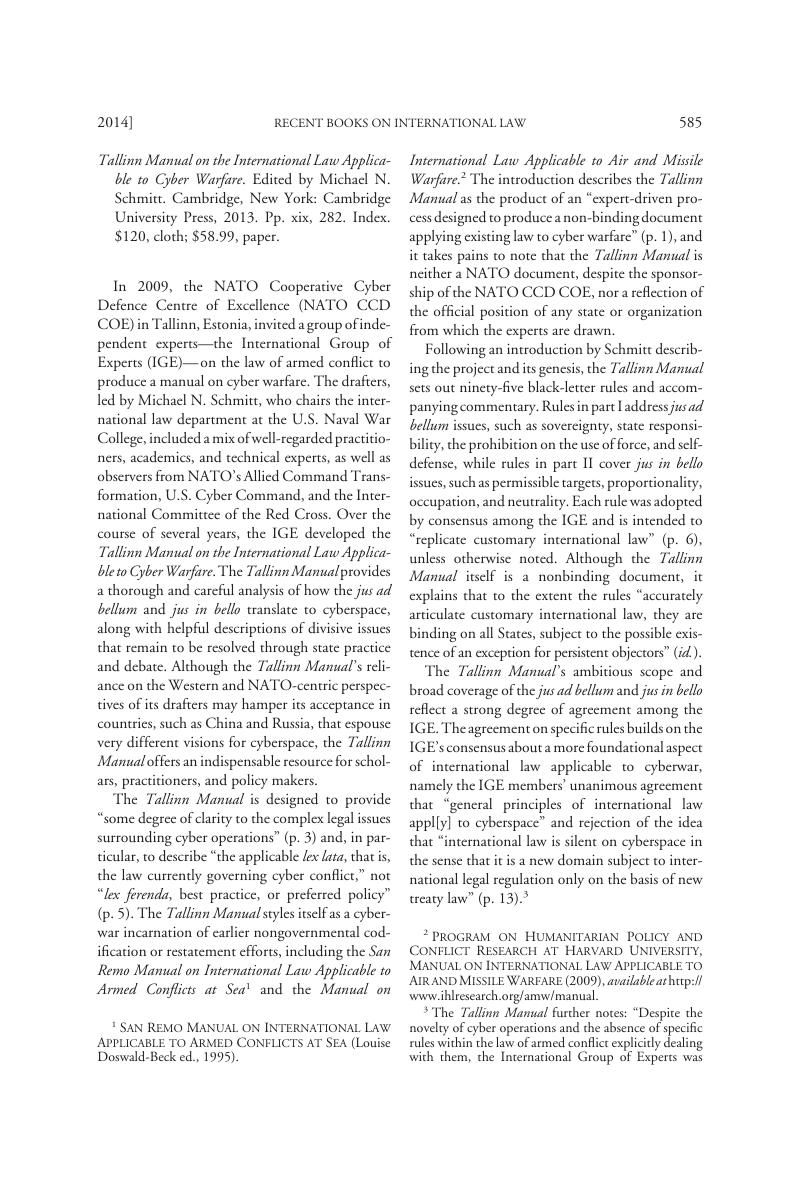Article contents
Tallinn Manual on the International Law Applicable to Cyber Warfare. Edited by Michael N. Schmitt. Cambridge, New York: Cambridge University Press, 2013. Pp. xix, 282. Index. $120, cloth; $58.99, paper.
Published online by Cambridge University Press: 20 January 2017
Abstract

- Type
- Recent Books on International Law
- Information
- Copyright
- Copyright © American Society of International Law 2014
References
1 San Remo Manual on International Law Applicable to Armed Conflicts at Sea (Louise Doswald-Beck ed., 1995).
2 Program on Humanitarian Policy and Conflict Research at Harvard University, Manual on International Law Applicable to Air and Missile Warfare(2009), available at http://www.ihlresearch.org/amw/manual.
3 The Tallinn Manual further notes: “Despite the novelty of cyber operations and the absence of specific rules within the law of armed conflict explicitly dealing with them, the International Group of Experts was unanimous in finding that the law of armed conflict applies to such activities in both international and noninternational armed conflicts... .” (p. 75).
4 Further disagreement among the IGE exists regarding the rule’s applicability to states through which a cyber operation is routed, in addition to the state from which an operation originates (pp. 28–29).
5 The Tallinn Manual states in the commentary to Rule 10 on the “[p]rohibition of threat or use of force,” that the “clearest cases are those cyber operations, such as the employment of the Stuxnet worm, that amount to a use of force” (p. 45).
6 For analysis from the United States, see, for example, U.S. National Security Council, International Strategy for Cyberspace: Prosperity, Security, and Openness in a Networked World 10,14(May 2011),at http://www.whitehouse.gov/sites/default/files/rss_viewer/international_strategy_for_cyberspace.pdf [hereinafter U.S. International Strategy for Cyberspace]; Koh, Harold Hongju, International Law in Cyberspace: Remarks as Prepared for Delivery by Harold Hongju Koh to the USCYBERCOM Inter-Agency Legal Conference Ft. Meade, MD, Sept. 18, 2012, 54 Harv. Int’l L.J. Online 1 (2012)Google Scholar, at http://www.harvardilj.org/2012/12/online_54_koh; Advance Questions for Vice Admiral Michael S. Rogers, USN Nominee for Commander, U.S. Cyber Command, Mar. 11,2014, at 11–12, at http://www.armed-services.senate.gov/download/rogers_03-11-14 (discussing U.S. military’s evaluation of use of force and self-defense with respect to cyber actions).
7 By way of explanation, the Tallinn Manual notes that these four national manuals are “publicly available” (p. 8). However, other studies have consulted and cited a broader range of national military manuals. For example, the study by the International Committee of the Red Cross on customary international humanitarian law used military manuals as evidence of state practice and cites military manuals from, inter alia, Cameroon, Colombia, Israel, Kenya, Nigeria, and Russia. 1 Henckaerts, Jeanmarie & Doswald-Beck, Louise, Int’l Comm. of the Red Cross, Customary International Humanitarian Law xxxii, 4 n.9, 8 n.40 (2005)CrossRefGoogle Scholar.
8 See, e.g., Office of the Secretary of Defense, Annual Report to Congress:Military and Security Developments Involving the People’s Republic of China 2013, at 36 (May 2013), at http://www.defense.gov/pubs/2013_china_report_final.pdf (“Although China has not yet agreed with the U.S. position that existing mechanisms, such as international humanitarian law, apply in cyberspace, Beijing’s thinking continues to evolve.”).
9 Report of the UN Group of Governmental Experts on Developments in the Field of Information and Tele communications in the Context of International Security, para. 19, UN Doc. A/68/98* (July 30, 2013); see id. at 12–13 (annex listing the members of the UN Group of Governmental Experts).
10 Compare U.S. International Strategy for Cyber space,supra note 6, at 22(advocating a multistakeholder governance model), with Ministry of Foreign Affairs of the People’s Republic of China, China, Russia, and Other Countries Submit the Document of International Code of Conduct for Information Security to the United Nations, para. 7 (Sept. 13, 2011), at http://nz.chineseembassy.org/eng/zgyw/t858978.htm (promoting multilateral governance model).
11 see NATO CCD COE, Tallinn 2.0 (undated), at http://www.ccdcoe.org/tallinn-20.html.
- 4
- Cited by


